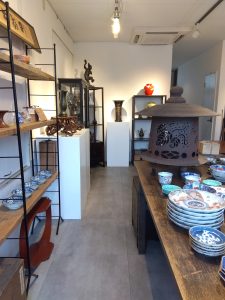季節を感じる色(愛知県名古屋市千種区姫池通 骨董品買取 古美術風光舎)
2024.03.24
みなさまこんにちは、スタッフTでございます。

本日はあいにくのお天気となりましたが、昨日、全国の気象台のトップを切って、高知県で桜(ソメイヨシノ)の開花が発表されましたね。
昨年は3月23日までに34地点の気象台でソメイヨシノの開花が観測されていたそうなので、今年は各地で昨年よりも遅くなっているようです。
今日は雨ですが、気温もそんなに低くないので、桜の開花を促す雨になりそうです。桜は開花から10日くらいは花がしっかりと付いているため、雨が降ってもすぐに散ってしまうことはほとんどありません。桜は咲き始めてから1週間程度で満開を迎えますので、来週はいよいよお花見が楽しめそうですよ。
日常の中にもピンクや黄色など、春を感じる広告などが溢れてきました。私たち日本人にとっての春「っぽい色」は季節感のある色を表しているのかもしれません。
色についていえば、日本には古来より伝わる伝統色というものがあります。春を表す日本の伝統色には、薄いピンクの「桜色」や、ピンクと赤の中間のような「紅梅色(こうばいいろ)」、薄い黄緑の「若葉色」、明るく鮮やかな黄色の「菜の花色」などがあります。
伝統色とは、和色とも呼ばれることがあり原色とは少し色味が違うという特徴があります。四季のある日本では古来より、草花や木々の色、空や山々の色など、季節によって表情を変える様々な色の変化を楽しんだとされています。美しい自然やそこで育まれた文化が作る微妙な色合いを感じ取り、名前をつけ、生まれたのが伝統色です。
また、色は位を表すものでもありました。律令制において、位によって着る衣服の色(袍の色)が決められ、他の人は着ることが許されなかった色を禁色と言います。禁色に対して、誰でも着ることが許された色を「ゆるし色」と言われました。
禁色としていちばん有名なのは、聖徳太子が定めたと言われる「冠位十二階」の色です。
最も位の高い人が着るのは、「濃紫」(こき)と呼ばれる濃く深い紫であり、最も低い位の色は「黒」でした。中でも薄黒という薄い黒(墨くろのような色)が最下位色でした。
色を濃く染めるには染料がたくさん必要なので、薄い色はどうしても位の低い人が着る色となったのでしょう。同じ紫でも濃紫(こき)に比べ、薄紫(うすき)は位が下がります。
昔はこうして官職によって着る服の色を制定し、その位の人以外は着ることが許されませんでした。
そして、どんなにがんばって立身出世しても、絶対に着ることが許されない「絶対禁色」という色がありす。それが、天皇の袍の色「黄櫨染」(こうろぜん)と、皇太子の袍の色「黄丹」(おうに)です。
今上天皇が「即位礼正殿の儀」でお召しになった金茶色の袍の色を覚えているのではないでしょうか?あの色が「黄櫨染」で、現代においても天皇以外は着ることが許されない日本の禁色です。
テレビでは赤茶や金茶のように映っていましたが、黄櫨染はウルシ科のハゼノキ(櫨)の樹皮と蘇芳から染め出される色で、この色を出すのはとても難しいのだそうです。黄と赤が混ざった茶色で、光の当たり方で赤茶にも黄茶にも見えるのだそうです。聖徳太子が『日出ずる処の天子』と称した太陽を象徴する色です。
時代ごとに色分けは少し違うのかもしれませんが、今ちょうど大河ドラマ「光る君へ」も放送されていますので、その辺りを気にして見るのもまた楽しいかもしれませんね。
ではでは、また。
Hello everyone, this is Staff T.
Unfortunately, today’s weather has been unfortunate, but yesterday, the blooming of cherry blossoms (Someiyoshino) was announced in Kochi Prefecture, leading all weather stations in Japan.
Last year, the blooming of Someiyoshino was observed at 34 weather stations by March 23, so it seems that this year’s blooming is later than last year in many areas.
It is raining today, but the temperature is not that low, so the rain is likely to promote the blooming of the cherry trees. Cherry blossoms are not likely to fall immediately even if it rains because the blossoms are firmly attached for about 10 days after blooming. Cherry blossoms are in full bloom about a week after they start blooming, so next week we will finally be able to enjoy cherry blossom viewing.
Even in our daily lives, we are now filled with pink, yellow, and other spring-inspired advertisements. For us Japanese, “spring-like” colors may represent colors that have a sense of the season.
Speaking of colors, there are traditional colors that have been handed down in Japan since ancient times. Traditional Japanese colors that represent spring include “sakura-iro,” a light pink, “koubai-iro,” a color between pink and red, “wakaba-iro,” a light yellowish green, and “nanohana-iro,” a bright and vivid yellow.
Traditional colors are also called Japanese colors, and are characterized by their slightly different tones from the primary colors. In Japan, which has four distinct seasons, people have long enjoyed the color of flowers and grasses, trees, the sky, and mountains, which change their expressions with the seasons. Traditional colors were created by sensing and naming the subtle hues created by the beautiful nature and culture nurtured there.
Color was also an expression of rank. Under the Ritsuryo system, the color of clothing (robe color) was determined according to rank, and colors that other people were not allowed to wear were called “forbidden colors. In contrast to forbidden colors, colors that anyone was allowed to wear were called “permitted colors.
The most famous forbidden colors are those of the “Twelve Grades of Crown Rank,” which are said to have been established by Prince Shotoku.
The color worn by those of the highest rank was a deep, dark purple called koki, while the color for those of the lowest rank was black. The lowest ranking color was black, and the lowest ranking color was a light black (like sumi-kuro) called usukuro.
Since it takes a lot of dye to dye a color darker, light colors were probably worn by people of lower ranks. Even within the same purple, light purple is lower in rank than dark purple.
In the old days, the color of clothing was determined according to the official position, and only those of that rank were allowed to wear it.
No matter how hard one worked to rise in the ranks, there was one color that was absolutely forbidden. These were korozome, the color of the emperor’s robe, and koutan, the color of the crown prince’s robe.
You may remember the color of the golden-brown robe worn by the current emperor at the accession ceremony. That color is “kirozome,” a color forbidden in Japan, and even today, only the emperor is allowed to wear it.
The color was shown on TV as reddish brown or golden brown, but it is a color produced from the bark of the Japanese sumac tree (Rhus succedanea), which belongs to the poison oak family, and from the Japanese sumac tree, Rhus succedanea, and it is very difficult to produce this color. It is a brown color mixed with yellow and red, and looks reddish brown or yellowish brown depending on the way the light hits it. It is said to be the traditional color symbolizing the sun, which Prince Shotoku called “the child of the rising sun.
The color classification may differ slightly from period to period, but since the historical drama “Hikaru Kimi he” is being broadcast right now, it may be fun to pay attention to that area as well.
So, see you soon.
*******************
ご実家の整理やお片付けなどをされている方のご相談などが多くございます。
お片付けなどくれぐれもご無理のないようになさってくださいませ。
風光舎では古美術品や骨董品の他にも絵画や宝石、趣味のお品など様々なジャンルのものを買受しております。
お片付けをされていて、こういうものでもいいのかしらと迷われているものでも、どうぞお気軽にご相談下さいませ。
また風光舎は、出張買取も強化しております。ご近所はもちろん、愛知県内、岐阜県、三重県その他の県へも出張いたします。
まずは、お電話お待ちしております。
愛知県名古屋市千種区姫池通
骨董 買取【古美術 風光舎 名古屋店】
TEL052(734)8444
10:00-18:00 OPEN

